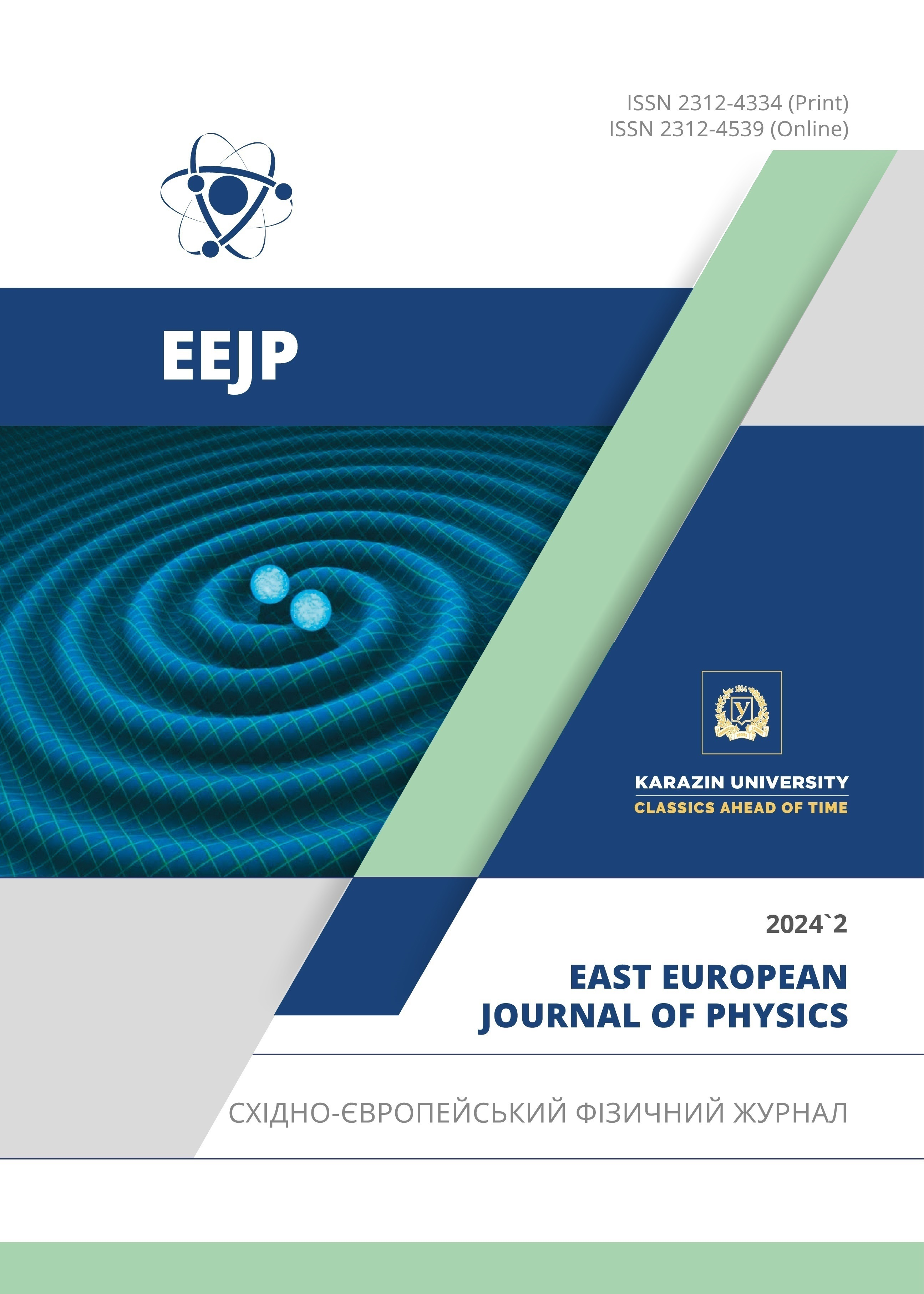Імовірності переходу, осцилятор та інтенсивність ліній у Sc XIX
Анотація
Іон скандію XIX є членом ізоелектронної послідовності Li-подібних іонів. Чисельне кулонівське наближення та квантовий дефект теорія була використана для розрахунку енергій, квантових дефектів і ймовірностей переходу, осцилятора та сили ліній іона Sc XIX для переходи ns → mp, np → ms, np → md і nd → mp ряд Рідберга. Енергії іонів Sc XIXX до n = 5 наведено в База даних NIST і література. Ми використали квантову теорію дефектів і визначили енергії та квантові дефекти до n = 30. енергії та квантових дефектів 125 рівнів повідомляється вперше. Імовірності переходу іона Sc XIX, осцилятор і лінія сили порівнювали з відповідними значеннями в базі даних спектральних ліній NIST. База даних NIST містить дані про лише сімдесят шість спектральних ліній. Лише шість спектральних ліній мають відсоткову невизначеність понад 10%. Результатів залишилося сімдесят спектральні лінії добре узгоджуються зі значеннями NIST. Майже 1800 ймовірностей переходів, осциляторів і інтенсивності ліній є новими.
Завантаження
Посилання
B. Thorsbro, Atomic Data Needs in Astrophysics: The Galactic Center “Scandium Mystery”, Atoms, 8(1), 4. (2020). https://doi.org/10.3390/atoms8010004
G. Alecian, F. LeBlanc, and G. Massacrier, “Scandium in AmFm stars in the light of new atomic data,” Astronomy & Astrophysics, 554, A89 (2013). https://doi.org/10.1051/0004-6361/201321156
H.W. Zhang, T. Gehren, and G. Zhao, „A non-local thermodynamic equilibrum study of scandium in the Sun,” Astronomy & Astrophysics, 481(2), 489-497 (2008). https://doi.org/10.1051/0004-6361:20078910
J.E. Lawler, C. Sneden, G. Nave, M.P. Wood, and J.J. Cowan, “Transition probabilities of Sc I and Sc II and Scandium abundances in the Sun, Arcturus, and HD 84937,” The Astrophysical Journal Supplement Series, 241(2), 21 (2019). https://doi.org/10.3847/1538-4365/ab08ef
X. Liu, and J. Zhang, “Quantum defects of 1s2nh configurations in Li-like system from Sc XIX to Zn XXVIII ion,” Journal of the Korean Physical Society, 80(12), 1107-1113 (2022). https://doi.org/10.1007/s40042-022-00465-3
V.A. Yerokhin, C.H. Keitel, and Z. Harman, “Two-photon-exchange corrections to the g factor of Li-like ions,” Physical Review A, 104(2), 022814 (2021). https://doi.org/10.1103/PhysRevA.104.022814
X. Liu, J.C. Zhang, and Z.W. Wang, “Theoretical calculation of ionization potentials and relativistic energies of high angular momentum 1s2ng states of Li-like ions,” Results in Physics, 12, 398-402 (2019). https://doi.org/10.1016/j.rinp.2018.11.087
V.A. Yerokhin, and A. Surzhykov, “Energy levels of core-excited 1s2l2l′ states in lithium-like ions: Argon to uranium,” Journal of Physical and Chemical Reference Data, 47(2) (2018). https://doi.org/10.1063/1.5034574
V.M. Shabaev, D.A. Glazov, A.V. Malyshev, and I.I. Tupitsyn, “Recoil effect on the g factor of Li-like ions,” Physical Review Letters, 119(26), 263001 (2017). https://doi.org/10.1103/PhysRevLett.119.263001
K.M. Aggarwal, and F.P. Keenan, “Energy levels, radiative rates, and electron impact excitation rates for transitions in Li-like ions with 12≤ Z≤ 20,” Atomic Data and Nuclear Data Tables, 99(2), 156-248 (2013). https://doi.org/10.1016/j.adt.2012.03.001
J. Sapirstein, and K.T. Cheng, “S-matrix calculations of energy levels of the lithium isoelectronic sequence,” Physical Review A, 83(1), 012504 (2011). https://doi.org/10.1103/PhysRevA.83.012504
W. Zhi-Wen, Y. Di, H. Mu-Hong, H. Qiu-Ju, and L. Jin-Ying, “Transition energy and oscillator strength of Sc18+ ion,” Chinese Physics, 14(8), 1559 (2005). https://doi.org/10.1088/1009-1963/14/8/015
T. Nishikawa, “Energy level data recommendation by screening constant,” Journal of Quantitative Spectroscopy and Radiative Transfer, 67(1), 43-54 (2000). https://doi.org/10.1016/S0022-4073(99)00192-2
E. BiÉmont, Y. Frémat, and P. Quinet, “Ionization potentials of atoms and ions from lithium to tin (Z= 50),” Atomic Data and Nuclear Data Tables, 71(1), 117-146 (1999). https://doi.org/10.1006/adnd.1998.0803
Z.C. Yan, M. Tambasco, and G.W.F. Drake, “Energies and oscillator strengths for lithiumlike ions,” Physical Review A, 57(3), 1652 (1998). https://doi.org/10.1103/PhysRevA.57.1652
Q.R. Zhu, S.F. Pan, and T.H. Zeng, “Energy levels, wavelengths, and radiative transition probabilities for the Li-like ions with 20≤ Z≤ 25,” Atomic data and nuclear data tables, 52(1), 109-141 (1992). https://doi.org/10.1016/0092-640X(92)90010-F
M. Saeed, and Z. Uddin, “Lifetimes of Fine Levels of Li Atom for 20< n< 31 by Extended Ritz Formula,” Canadian Journal of Physics, (January), (2023). https://doi.org/10.1139/cjp-2023-0220
M. Saeed, S.U. Rehman, M.M. Khan, and Z. Uddin, “Computation of Characteristics of C IV Transitions,” East European Journal of Physics, (2), 165-172 (2023). https://doi.org/10.26565/2312-4334-2023-2-16
R. Siddique, R. Zafar, S. Raza, S.Z. Iqbal, and Z. Uddin, “Mean Lifetimes of ns, np, nd, & nf Levels of NV,” East European Journal of Physics, (3), 424-429 (2023). https://doi.org/10.26565/2312-4334-2023-3-46
R. Siddiq, M.N. Hameed, M.H. Zaheer, M.B. Khan, and Z. Uddin, “Rydberg energies and transition probabilities of Li I for np–ms (m≤ 5) transitions,” Beni-Suef University Journal of Basic and Applied Sciences, 11(1), 1-9 (2022). https://doi.org/10.1186/s43088-022-00224-0
National Institute of Standards and Technology, 100 Bureau Drive Gaithersburg, MD 20899, 301-975-2000, USA, https://physics.nist.gov/PhysRefData/ASD/lines_form.html
Авторське право (c) 2024 Мухаммад Калім, Саба Джавайд, Рухі Зафар, Захір Уддін

Цю роботу ліцензовано за Міжнародня ліцензія Creative Commons Attribution 4.0.
Автори, які публікуються у цьому журналі, погоджуються з наступними умовами:
- Автори залишають за собою право на авторство своєї роботи та передають журналу право першої публікації цієї роботи на умовах ліцензії Creative Commons Attribution License, котра дозволяє іншим особам вільно розповсюджувати опубліковану роботу з обов'язковим посиланням на авторів оригінальної роботи та першу публікацію роботи у цьому журналі.
- Автори мають право укладати самостійні додаткові угоди щодо неексклюзивного розповсюдження роботи у тому вигляді, в якому вона була опублікована цим журналом (наприклад, розміщувати роботу в електронному сховищі установи або публікувати у складі монографії), за умови збереження посилання на першу публікацію роботи у цьому журналі.
- Політика журналу дозволяє і заохочує розміщення авторами в мережі Інтернет (наприклад, у сховищах установ або на особистих веб-сайтах) рукопису роботи, як до подання цього рукопису до редакції, так і під час його редакційного опрацювання, оскільки це сприяє виникненню продуктивної наукової дискусії та позитивно позначається на оперативності та динаміці цитування опублікованої роботи (див. The Effect of Open Access).








